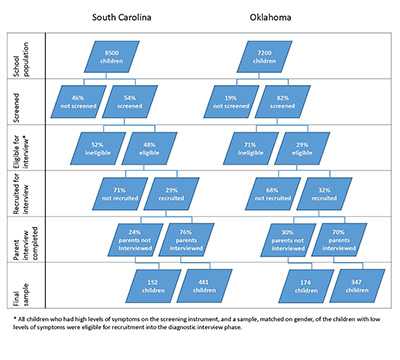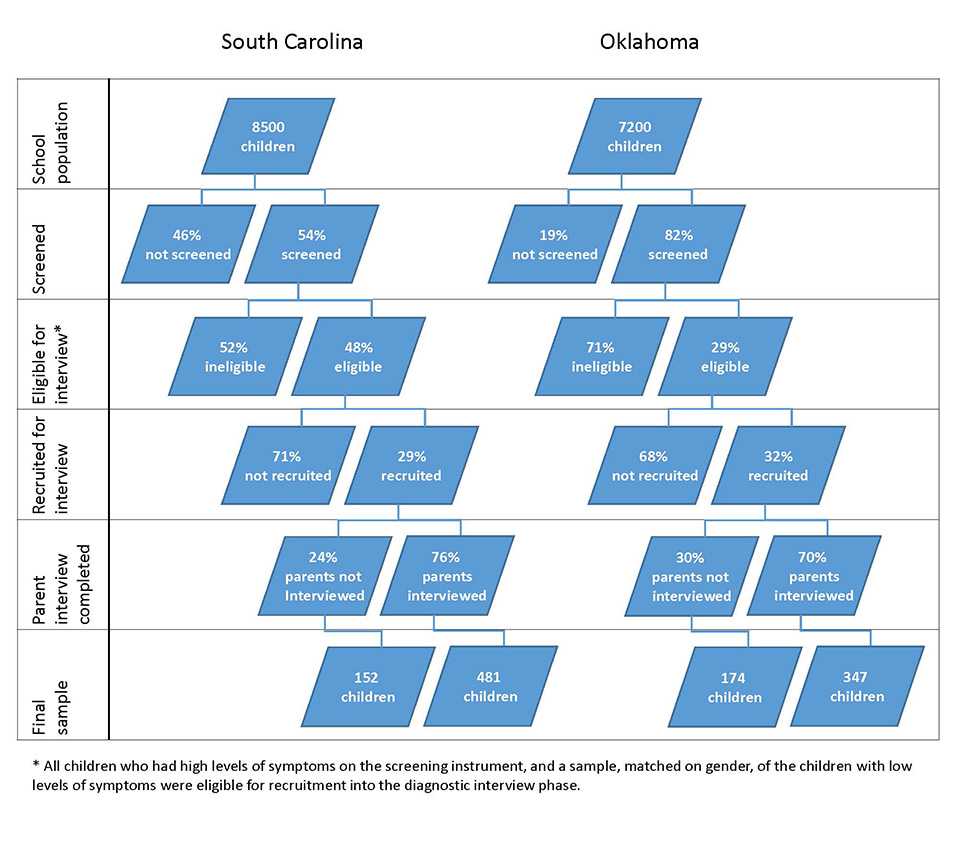Project to Learn About ADHD in Youth (PLAY)
Study Questions
The Project to Learn About ADHD in Youth (PLAY) study was designed to better understand the public health impact of ADHD, including
- The prevalence of ADHD in school-age children
- Current and previous treatment patterns of children with ADHD
- ADHD symptoms and how they change over time
- The impact of ADHD on children’s development and on their families
- The existence of co-occurring and secondary conditions in children with ADHD
- The types and rates of health risk behaviors in children with ADHD
Learn about the PLAY study methods on this page.
Enrollment flow chart for PLAY Study sites
About the Study
CDC funded two research sites, the University of South Carolina (principal investigator Robert E. McKeown, PhD) and the University of Oklahoma Health Sciences Center (principal investigator Mark L. Wolraich, MD).
The study included children in these two communities from six school districts with diverse populations from varied geographical settings. Because the study population was drawn from a school-based sample and followed through multiple waves of data collection, it provided information on ADHD symptoms and diagnosis in communities and children’s development over time.
The baseline study conducted between 2002 and 2006 included a 2-step screening process. First, teachers and parents of over 10,000 public school elementary students (kindergarten through 6th grade) in the selected school districts were asked about signs and symptoms of ADHD in these children. Next, students with a high number of indicators from that screening who were considered high risk for ADHD were invited for an in-depth assessment. Similarly, a subset of students with a low number of indicators who were considered low risk for ADHD were selected as a comparison group and invited for in-depth assessment.
This method of selecting children was designed to identify two groups of children: (1) children who were already diagnosed with ADHD and (2) children who were likely to have ADHD, but had not yet been diagnosed with the condition, so as to be able to learn more about their development over time.
The students identified at the baseline assessment were invited to participate in additional studies over time as they progressed into middle and high school. The purpose was to track how children diagnosed with ADHD or likely to have ADHD changed and developed over time, and what role ADHD played in this development over time. This study was different from many other studies of children diagnosed with ADHD because it included children from the community—not enrolled through clinic visits—so as to get the most comprehensive picture of the full spectrum of children with ADHD.
About the Measures
The study included information collected from parents, teachers, and the child. The follow-up project spanned five years and included annual in-depth interviews, semi-annual data collection on a few measures, and brief quarterly contacts.
Assessment Matrix for PLAY Study
|
Follow up |
|||||
|---|---|---|---|---|---|
|
Surveys/ Instruments |
Baseline |
Wave 1-2 |
Wave 3-4 |
||
|
Parent |
OK |
Annual |
Semi- annual |
Annual |
Semi- annual |
|
OK* |
SC & OK |
SC |
|||
|
ADHD Treatment, Cost, and Client Satisfaction |
OK* |
SC & OK |
SC |
||
|
ADHD Communication and Knowledge |
SC & OK |
SC |
|||
|
Brief Impairment Scale |
SC & OK |
SC |
|||
|
Critical School Events |
SC & OK |
SC |
|||
|
Demographic Survey |
SC & OK |
SC & OK |
SC |
||
|
Developmental Assets |
SC |
||||
|
Diagnostic Interview Schedule for Children |
SC & OK |
SC & OK |
SC |
||
|
Health Risk Behavior Survey |
SC & OK |
SC & OK |
SC |
||
|
Parent-Child Relationship Inventory |
SC |
SC & OK |
SC |
||
|
Parents’ Mental Health Questionnaire |
SC |
SC & OK |
SC |
||
|
Parent Pediatric Quality of Life Inventory |
SC |
OK |
|||
|
Social Isolation/Support |
SC & OK |
SC |
|||
|
Strengths and Difficulties Questionnaire |
SC & OK |
SC & OK |
SC & OK |
SC |
SC |
|
Vanderbilt ADHD Diagnostic Parent Rating Scale |
SC & OK |
SC & OK |
SC & OK |
SC |
SC |
|
OK |
|||||
|
Child |
|||||
|
Brief Sensation Seeking Scale |
SC & OK |
SC |
|||
|
Diagnostic Interview Schedule for Children |
SC |
SC & OK |
SC |
||
|
Health Risk Behavior Survey |
SC & OK |
SC |
|||
|
Inventory of Parent and Peer Attachment /People In My Life |
SC & OK |
||||
|
SC & OK |
|||||
|
Marsh Self-Description Questionnaire |
SC |
SC & OK |
SC |
||
|
Youth Demographic Survey |
SC & OK |
SC |
|||
|
Pediatric Quality of Life Inventory |
SC |
SC & OK |
SC |
||
|
Teacher |
|||||
|
Vanderbilt ADHD Diagnostic Teacher Rating Scale |
SC & OK |
SC & OK |
SC |
||
|
Strengths and Difficulties impairment question |
SC & OK |
SC & OK |
SC |
||
|
Critical Events |
SC & OK |
SC |
|||
SC: Data collected in South Carolina
OK: Data collected in Oklahoma
*Measure was modified for follow-up study
1 The ADHD treatment questionnaire and updates to Events and Demographics were also collected quarterly
2 These data were collected in 2 districts only, for an additional study on tic disorders
3 For participants who did not attend Wave 1, this was administered at the first subsequent visit
Note: For the baseline, both sites collected a core set of measures but also added site-specific measures of interest. For the two waves of follow-up, sites chose to use very similar assessment protocols. South Carolina was able to conduct two additional waves of information collection.
Results from the study
Data analysis is continuing. You can find out about the results to date by reading the key findings below.
Key Findings
Impact of ADHD and Other Mental Conditions
Data from a community study show that children with ADHD and other conditions are more likely to have problems with friendships and to get into trouble in school or with the police.
(Published November 25, 2015)
Estimates of ADHD Change Depending on Which ADHD Criteria Are Applied
Using more criteria to diagnose children with ADHD decreases the percentage of children who fit the diagnosis.
(Published November 11, 2014)
Persistence of Attention-Deficit/Hyperactivity Disorder Symptoms
Data from a community sample show that certain ADHD symptoms can often last into adolescence.
(Published July 3, 2014)
ADHD Prevalence in Two Communities
ADHD diagnosis and treatment in a study of children in two school-based samples.
(Published: September 11, 2012)
- Page last reviewed: September 6, 2017
- Page last updated: April 11, 2016
- Content source:


 ShareCompartir
ShareCompartir

